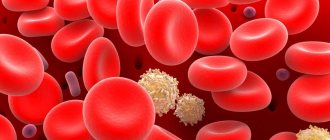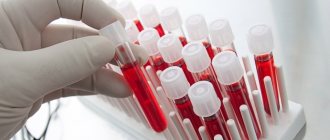It is very important to monitor your baby's health with regular blood tests. All indicators must be within certain limits, but deviations can indicate as yet imperceptible inflammatory processes. Neutrophils, which are a type of leukocyte, play a special role in determining the baby’s health. These cells are divided into several types, and the meaning of each of them carries certain information.
The child’s health status is monitored using a blood test, the value of which parents need to know
The importance of neutrophils in the diagnosis of diseases
Cell characteristics
As mentioned above, neutrophils are a type of granulocytic leukocyte. They belong to this group of white blood cells, since they have granules in their composition, or rather in the cytoplasm. They contain various types of compounds: proteins, enzymes, and so on. They provide functions to neutrophilic leukocytes.
Role in the body
Neutrophils make up the majority of all leukocytes. Everyone knows that white blood cells protect our body. How does this happen?
When a foreign agent enters the body, substances are produced that attract neutrophils to the site of penetration. There, neutrophil leukocytes phagocytose, that is, absorb a foreign agent. The granules contained inside the neutrophil help digest the foreign compound.
The difference between neutrophils and other cells that can “eat” other molecules is their viability after phagocytosis. Neutrophils participate in phagocytosis once in their lives (after which they die), while other macrophages can do this many times.
Thus, this type of leukocyte is one of the first factors in the body’s defense against foreign agents.
Type of neutrophils
There are several types of leukocytes, differing in maturity. Initially, the maturation of this type of leukocyte begins in the same way as others - from a precursor cell. Then, during differentiation, a myeloblast is formed from it, then a promyelocyte. Already at this stage, granules begin to appear in the cells. Next, a myelocyte is formed, then a metamyelocyte. It is also called a young neutrophil.
Under some conditions, young neutrophilic leukocytes can be detected in the peripheral blood.
A band form is formed from the metamyelocyte. It is named after the shape of the kernel at this stage of maturation. The final, mature cell is the segmented neutrophil. It differs from its predecessor in the structure of the nucleus: segments are formed from the so-called rod, connected by constrictions.
Features and functions of band neutrophils
As many people, even those practically unrelated to medicine, already know, leukocytes play a major role in providing immunity, and each type is responsible for a specific function. Neutrophils are the largest group of white blood cells, and their task is to absorb and digest pathogenic bacteria and viruses, so-called phagocytosis.
The latter is carried out due to the ability of these cells to penetrate through vascular walls, various tissues and be directed to the immediate site of the lesion. After the destruction of pathogenic microorganisms, neutrophils die, and in their place new cells are constantly formed, which go through several stages of maturation.
According to this criterion, they are divided into SY and PL. The youngest neutrophils, those just beginning to mature, are called band neutrophils. They received this name due to the special structure of the nucleus. At this stage, it resembles an oblong stick, and only then it transforms into separate segments.
Reference! The production of neutrophils is carried out by the bone marrow, liver and spleen, and a malfunction of one of the organs certainly affects their number, which can be seen in the results of a general blood test.
These cells do not yet have the ability to pass through tissues and vessel walls, and therefore cannot take part in phagocytosis itself. They do not yet have the required amount of enzymes to perform this complex task. Their role is to mature and then transform into full-fledged segmented neutrophils, which will carry out their protective function.
When pathogenic microorganisms enter the body and the inflammatory process develops, the number of neutrophils rapidly increases. This is due to the death of spent mature cells and the natural production of young or immature ones.
This phenomenon is observed in most pathologies and is considered an adequate response of the body, since it needs a large number of new neutrophils to continue to fight pathogens. But if such a change is detected in a general blood test, it will become clear that somewhere in the body an inflammatory or infectious disease is developing.
Stages of neutrophil maturation
Indications for referral for analysis
- Determination of neutrophil levels can be carried out as part of an annual preventive examination in children and adults. This is a way to identify hidden diseases that do not yet have clinical symptoms.
- A study of the leukocyte content is determined in order to determine whether there is an infectious process in the body. Perhaps this is the main indication for prescribing an analysis of the level of neutrophil leukocytes in the blood. That is, by analyzing the level of white blood cells, we can draw a conclusion about the body’s ability to resist infections. This is an important characteristic of children's health.
- One of the indications for studying the content of this type of cells is the diagnosis of malignant blood diseases. This may be evidenced by the detection of young and blast forms of neutrophils
- A conclusion about the effectiveness of treatment can also be made based on data on the level of neutrophils over time.
What to do if the analysis is not normal?
To date, there are no simple ways to change the ratio of certain leukocyte cells in the blood. The doctor must find out the reasons for the deviation and try to adjust the blood count using indirect methods. If the root of the problem lies in taking medications, they should be removed or replaced. Sometimes the situation can be corrected by eating foods rich in B vitamins (B9 and B12).
Neutrophils in a baby’s blood may not correspond to the norm for various reasons (more details in the article: why are neutrophils in a child’s blood low?). The result of the analysis cannot become the main diagnostic tool. The doctor must evaluate other symptoms and examination results in order to make a diagnosis. However, deviations in the blood formula cannot be ignored, so as not to miss the first signs of inflammation or any disease.
Pediatrician of the 2nd category, allergist-immunologist, graduated from the Belarusian State Medical University of the Federal Agency for Health and Social Development. Read more »
How is the level of neutrophils in the blood calculated?
To perform a neutrophil count, blood is required. Any one is suitable for this: taken from a vein or capillary. In newborns, blood may be taken from the heel. The study of the type of white blood cells is called leukocyte count. It is performed during a general clinical blood test (CBC).
This study is most often carried out using a microscope and a special cell counter. The specialist examines the blood smear and counts all the types of cells that he saw. Counts one hundred cells in a smear. Next, writes the result on the answer form.
Staining of smears is used to differentiate different cells from each other. The Romanowsky-Giemsa method is most often used for staining blood smears.
For heavy laboratory workloads, it is possible to count cells using an automatic hematology analyzer. But not all laboratories can be equipped with such devices. Which brings us back to the manual method and the value of experts in the field.
Do you need any preparation for the analysis?
If the patient wants to get a reliable result of a blood test, then it is necessary to prepare. Moreover, the rules are very simple.
- Blood is donated on an empty stomach. Children under one year of age should not eat for 30–40 minutes before blood sampling. Older people – 3-4 hours.
- emotionally calm before donating blood .
- The level of physical activity also matters. Do not burden yourself or your child with training or sporting events. Even running down a hospital hallway can affect your results.
- There are situations where medications interfere with results . If the patient takes anything, the doctor should be notified so that he takes this into account when interpreting the study results.
When neutrophils are elevated
If a child's blood test shows high neutrophils, the condition is called neutrophilia and can be caused by many factors. For example, if the increase is insignificant, there is a possibility that this is the body’s reaction to the baby’s activity - he was running or playing happily before blood sampling. When neutrophils are significantly elevated, the doctor will recommend undergoing an examination. Diseases and other factors that can cause an increase in neutrophils:
- leukemia;
- vaccination;
- peritonitis;
- pneumonia, otitis media, sepsis, bronchitis, tonsillitis;
- third and fourth degree burns;
- abscesses;
- hemolytic anemia;
- diabetes;
- trophic ulcers.
The most common causes of increased neutrophil levels in the blood
Band shift
There is such a thing as a shift of the leukocyte formula to the left. This means that the ratio between mature and young forms of neutrophil leukocytes changes towards an increase in the level of the latter.
The shift can be of varying degrees. The result of the analysis will depend on the increase in which forms the shift occurs: stab, juvenile, and so on.
The condition when neutrophils are increased in the blood of a child and an adult is called neutrophilosis.
Band neutrophils may be elevated in the following cases:
- infectious process in the body. Due to the lack of neutrophils, signals are sent to the bone marrow, where cell maturation occurs, to produce new “fighters”. Therefore, not fully matured cells enter the bloodstream;
- blood loss stimulates the bone marrow to synthesize all blood cells, not just leukocytes;
- after intense physical activity and stress;
- after operation;
- pregnancy.
Still, the main reason for the high number of these types of leukocytes is the inflammatory process, which they intensively fight.
With malignant pathologies, almost all forms of neutrophil maturation, including blast cells, can appear in the blood.
High level of segmented neutrophils
Segmented neutrophils are mature cells. An increase in their number in the blood will be called a shift in the leukocyte formula to the right.
There are a number of conditions when segmented neutrophils are elevated in the blood of children and adults. These include:
- deficiency of vitamins necessary for the maturation of new cells, for example, vitamin B12 and folic acid;
- increased background radiation in the surrounding area;
- lung diseases;
- liver pathology;
- kidney diseases;
- recent blood transfusion.
Increased neutrophils during pregnancy
An increase in the number of this type of white blood cells during pregnancy is considered normal. Since at this time everything in the body of the expectant mother is rebuilt and changes.
In response to the appearance of a half genetically foreign child in the body, the synthesis of leukocytes is stimulated. Therefore, their level can be increased. Next, there is constant monitoring of various indicators in a pregnant woman in order to notice deviations in time and have time to influence them.
During pregnancy, the mother's immune system decreases slightly, making the body more susceptible to various infections. An increased number of protective cells helps to avoid serious complications.
Quantity change
Deviations in the number of PN neutrophils from normal values are directly related to fluctuations in the total content of leukocytes and, in particular, granulocytes. After all, all five components of the leukocyte formula (neutrophils, lymphocytes, basophils, eosinophils and monocytes) are directly involved in the implementation of immune defense.
Therefore, when faced with alien objects, they undergo changes to varying degrees. The need to increase the level of the immune response and the beginning of the fight against pathogens causes a corresponding increase in the production of young neutrophils and their subsequent maturation into segmented functionally capable cells.
After a few days, the SCs die when interacting with the infection, and they are replaced by new ones that grow from rod cells. A general decrease in the number of neutrophils is always reflected in a decrease in the number of PNs, and sometimes their complete absence in the blood can be observed.










